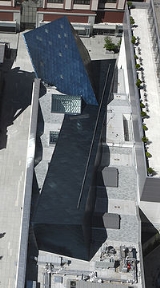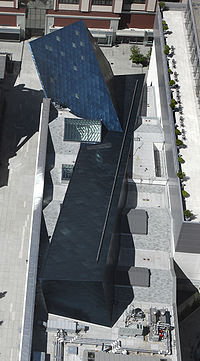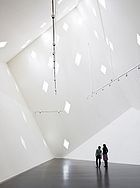
Contemporary Jewish Museum
Encyclopedia
The Contemporary Jewish Museum (CJM) was founded in 1984 in San Francisco, California
, with the goal of offering contemporary perspectives on Jewish culture, history, art, and ideas. In June 2008, the Museum moved to the Yerba Buena Gardens
district of San Francisco’s South of Market neighborhood, into a new building designed by architect
Daniel Libeskind
.
 The museum began in 1984 as the Jewish Community Museum located in San Francisco’s financial district. Ten years later, the board decided to move to the Yerba Buena Gardens on Mission Street. Architect Peter Eisenman
The museum began in 1984 as the Jewish Community Museum located in San Francisco’s financial district. Ten years later, the board decided to move to the Yerba Buena Gardens on Mission Street. Architect Peter Eisenman
proposed a design for the new building, but the museum’s trustees and local residents rejected it.
In 1998, the museum hired Daniel Libeskind and construction began in 2006.
The museum has no permanent collection. Instead, it curates and hosts a broad array of exhibitions, such as “In the Beginning: Artists Respond to Genesis” and "From The New Yorker to Shrek: The Art of William Steig
," throughout the year.
Former Whitney Museum curator Connie Wolf became the museum’s director in 1999.
, originally designed by Willis Polk
. Delays and budget issues forced Libeskind to alter his original design for the building, which was completed in 2008. The museum cost $47.5 million to build.
 The museum’s tilted, dark-blue stainless steel
The museum’s tilted, dark-blue stainless steel
cube, constructed by A. Zahner Company
, slices into the old substation’s brick
, making visible the relationship between the new and the old. Libeskind’s design preserves the defining features of Polk’s old building, including its brick façade
, trusses, and skylights. 36 diamond-shaped windows light the top floor of the metal cube, known as the Yud, which hosts sound and performance based exhibitions. The museum’s other section, a slanting rectangle known as the Chet, holds the narrow lobby, an education center, and part of an upstairs gallery.
Similar to Libeskind’s Danish Jewish Museum
in Copenhagen
, the Contemporary Jewish Museum incorporates text into its design. Inspired by the phrase “L’Chaim,” meaning “To Life,” Libeskind let the Hebrew letters that spell “chai
” —“chet
” and “yud
,” inspire the form of the building. The Hebrew word pardes
, meaning “orchard
,” is embedded in the wall of the lobby.
The building also houses a multi-purpose event space, an auditorium, a café, and the museum store.
, praise Libeskind for a “careful balance of explosive and well-behaved forms” and gallery designs that abandon the architect’s characteristic slanted walls. Likewise, David D’Arcy of the Wall Street Journal sees the museum as a laudable departure from Libeskind’s previous work. He finds a “lightness to this [museum] that is rare in the architect’s work” and that “relieves the surrounding district’s glass and steel tourist-mall monotony.” D’Arcy, however, bemoans the project’s budgetary restrictions, which he argues are apparent in the museum’s “architecturally clumsy” multi-purpose space.
Edward Rothstein
of the New York Times criticizes the museum for its dedication to “multiple perspectives and open-mindedness…without a grounding in knowledge, without history, detail, object and belief.” Without a permanent collection, the Contemporary Jewish Museum forgoes a sense of a collective Jewish past, he says.
California
California is a state located on the West Coast of the United States. It is by far the most populous U.S. state, and the third-largest by land area...
, with the goal of offering contemporary perspectives on Jewish culture, history, art, and ideas. In June 2008, the Museum moved to the Yerba Buena Gardens
Yerba Buena Gardens
Yerba Buena Gardens is the name for two blocks of public parks located between Third and Fourth, Mission and Folsom Streets in downtown San Francisco, California. The first block bordered by Mission and Howard Streets was opened in 1993. The second block, between Howard and Folsom Streets was...
district of San Francisco’s South of Market neighborhood, into a new building designed by architect
Architect
An architect is a person trained in the planning, design and oversight of the construction of buildings. To practice architecture means to offer or render services in connection with the design and construction of a building, or group of buildings and the space within the site surrounding the...
Daniel Libeskind
Daniel Libeskind
Daniel Libeskind, is an American architect, artist, and set designer of Polish-Jewish descent. Libeskind founded Studio Daniel Libeskind in 1989 with his wife, Nina, and is its principal design architect...
.
History

Peter Eisenman
Peter Eisenman is an American architect. Eisenman's professional work is often referred to as formalist, deconstructive, late avant-garde, late or high modernist, etc...
proposed a design for the new building, but the museum’s trustees and local residents rejected it.
In 1998, the museum hired Daniel Libeskind and construction began in 2006.
The museum has no permanent collection. Instead, it curates and hosts a broad array of exhibitions, such as “In the Beginning: Artists Respond to Genesis” and "From The New Yorker to Shrek: The Art of William Steig
William Steig
William Steig was a prolific American cartoonist, sculptor and, later in life, an author of popular children's literature...
," throughout the year.
Former Whitney Museum curator Connie Wolf became the museum’s director in 1999.
Architecture
Daniel Libeskind designed the 63,000 square foot (5,900 square meter) museum, which occupies and extends the 1907 Jesse Street Power SubstationElectrical substation
A substation is a part of an electrical generation, transmission, and distribution system. Substations transform voltage from high to low, or the reverse, or perform any of several other important functions...
, originally designed by Willis Polk
Willis Polk
Willis Jefferson Polk was an American architect best known for his work in San Francisco, California.-Life:He was born in Jacksonville, Illinois and was related to United States President James Polk....
. Delays and budget issues forced Libeskind to alter his original design for the building, which was completed in 2008. The museum cost $47.5 million to build.
Design

Steel
Steel is an alloy that consists mostly of iron and has a carbon content between 0.2% and 2.1% by weight, depending on the grade. Carbon is the most common alloying material for iron, but various other alloying elements are used, such as manganese, chromium, vanadium, and tungsten...
cube, constructed by A. Zahner Company
Zahner
Zahner or A. Zahner Company is an architectural metal & glass company located in Kansas City, Missouri.-History and Company Information:...
, slices into the old substation’s brick
Brick
A brick is a block of ceramic material used in masonry construction, usually laid using various kinds of mortar. It has been regarded as one of the longest lasting and strongest building materials used throughout history.-History:...
, making visible the relationship between the new and the old. Libeskind’s design preserves the defining features of Polk’s old building, including its brick façade
Facade
A facade or façade is generally one exterior side of a building, usually, but not always, the front. The word comes from the French language, literally meaning "frontage" or "face"....
, trusses, and skylights. 36 diamond-shaped windows light the top floor of the metal cube, known as the Yud, which hosts sound and performance based exhibitions. The museum’s other section, a slanting rectangle known as the Chet, holds the narrow lobby, an education center, and part of an upstairs gallery.
Similar to Libeskind’s Danish Jewish Museum
Danish Jewish Museum
The Danish Jewish Museum, in Copenhagen, Denmark, sits inside the Danish Royal Library’s old Galley House and exhibits Danish Jewish historical artifacts and art. Designed by world-renowned architect Daniel Libeskind, the building memorializes the story of Danish Jews who were saved from Nazi...
in Copenhagen
Copenhagen
Copenhagen is the capital and largest city of Denmark, with an urban population of 1,199,224 and a metropolitan population of 1,930,260 . With the completion of the transnational Øresund Bridge in 2000, Copenhagen has become the centre of the increasingly integrating Øresund Region...
, the Contemporary Jewish Museum incorporates text into its design. Inspired by the phrase “L’Chaim,” meaning “To Life,” Libeskind let the Hebrew letters that spell “chai
Chai (symbol)
Chai is a symbol and word that figures prominently in Jewish culture. It consists of the letters of the Hebrew alphabet Chet and Yod .The Hebrew word "living" is related to the term for "life", chaim; ḥayyim....
” —“chet
Het
Het or HET can refer to:Acronyms* Hall Effect Thruster, an electric propulsion device for space applications* Heavy Equipment Transporter, a military vehicle...
” and “yud
Yodh
Yodh is the tenth letter of many Semitic alphabets, including Phoenician, Aramaic, Hebrew Yud , Syriac and Arabic...
,” inspire the form of the building. The Hebrew word pardes
Pardes (legend)
Pardes is the subject of a Jewish aggadah about four rabbis of the Mishnaic period who visited the Orchard :...
, meaning “orchard
Orchard
An orchard is an intentional planting of trees or shrubs that is maintained for food production. Orchards comprise fruit or nut-producing trees which are grown for commercial production. Orchards are also sometimes a feature of large gardens, where they serve an aesthetic as well as a productive...
,” is embedded in the wall of the lobby.
The building also houses a multi-purpose event space, an auditorium, a café, and the museum store.
Reaction
Critics, such as Christopher Hawthorne of the Los Angeles TimesLos Angeles Times
The Los Angeles Times is a daily newspaper published in Los Angeles, California, since 1881. It was the second-largest metropolitan newspaper in circulation in the United States in 2008 and the fourth most widely distributed newspaper in the country....
, praise Libeskind for a “careful balance of explosive and well-behaved forms” and gallery designs that abandon the architect’s characteristic slanted walls. Likewise, David D’Arcy of the Wall Street Journal sees the museum as a laudable departure from Libeskind’s previous work. He finds a “lightness to this [museum] that is rare in the architect’s work” and that “relieves the surrounding district’s glass and steel tourist-mall monotony.” D’Arcy, however, bemoans the project’s budgetary restrictions, which he argues are apparent in the museum’s “architecturally clumsy” multi-purpose space.
Edward Rothstein
Edward Rothstein
Edward Rothstein is a critic and a composer.Rothstein holds a B.A. from Yale University , an M.A. in English literature from Columbia University, and a Ph.D. from the Committee on Social Thought at the University of Chicago...
of the New York Times criticizes the museum for its dedication to “multiple perspectives and open-mindedness…without a grounding in knowledge, without history, detail, object and belief.” Without a permanent collection, the Contemporary Jewish Museum forgoes a sense of a collective Jewish past, he says.

